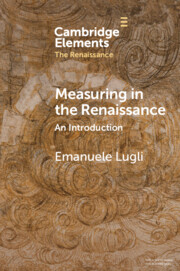Element contents
Measuring in the Renaissance
Published online by Cambridge University Press: 12 July 2023
Summary
Keywords
- Type
- Element
- Information
- Series: Elements in the RenaissanceOnline ISBN: 9781009072830Publisher: Cambridge University PressPrint publication: 03 August 2023
Bibliography
Primary Sources
Secondary Sources
- 9
- Cited by

